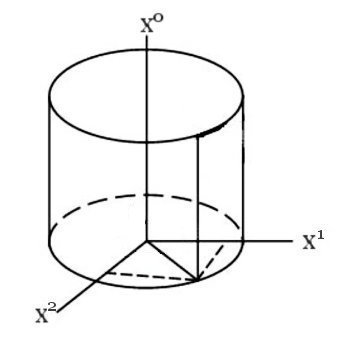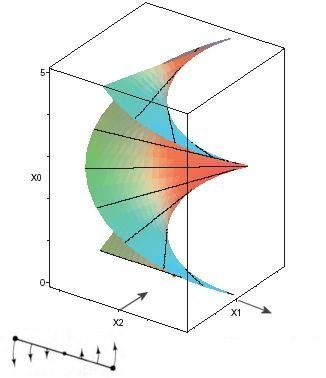 |
The Lorentz transformation in special relativity has been generalized to D-dimensions. The requirement of Lorentz covariant is to make sure that the superstring theory behaves the same in all inertial frames. Just as in gauge field theory or general relativity, there are fewer independent dynamical degrees of freedom than appear explicitly in the action. The degrees of freedom in the formulation can be reduced via the requirement of conformal invariance under the conformal transformation (Figure 01b), which rescale the world sheet metric. Such change in topology makes it feasible to evaluate string diagrams. Among other things this makes it possible to compactify the world sheet, closing off the holes corresponding to incoming and outgoing strings. For example, a world sheet with one incoming and one outgoing string (as in (a) of Figure 01b) can be conformally mapped to the plane of (a') with the incoming string appearing at the origin and the outgoing string at infinity (not shown) or to the sphere of (a") with the incoming and outgoing strings appearing at the south and north poles¶. The external string states in (b) of Figure 01b with four awkward legs are projected to points as indicated in (b'). By a suitable choice of gauge (known as covariant or conformal gauge with in the following case - a gauge is a mathematical device to fix the redundant degrees of freedom), the string equations of motion can be derived by varying X in the following case - a gauge is a mathematical device to fix the redundant degrees of freedom), the string equations of motion can be derived by varying X to minimize the action S, thus we obtain: to minimize the action S, thus we obtain:
|

 (
( ,
, ) trace out a curve as
) trace out a curve as  varies at fixed
varies at fixed  . The curve may be open or closed and
. The curve may be open or closed and  varies within a range between 0 and
varies within a range between 0 and  as the string is traced out from one end to the other for an open string, or 0 to 2
as the string is traced out from one end to the other for an open string, or 0 to 2 round the circle for a closed string. The string sweeps out a worldsheet as
round the circle for a closed string. The string sweeps out a worldsheet as  varies from one instant to another. However, these two parameters have nothing whatsoever to do with the real space and real time. Since nobody has ever seen or detected this artificial space-time, they have to be hidden from the observables in a theory, and thus the requirement of reparametrization invariance. It turns out that such theory can be formulated only with the one-dimensional string within the framework of artificial space-time.
varies from one instant to another. However, these two parameters have nothing whatsoever to do with the real space and real time. Since nobody has ever seen or detected this artificial space-time, they have to be hidden from the observables in a theory, and thus the requirement of reparametrization invariance. It turns out that such theory can be formulated only with the one-dimensional string within the framework of artificial space-time.
 = 1 and c = 1. The tension of the string can be estimated from the strength of the force transmitted by the graviton. It is inversely proportional to the strength of the gravitational constant by the formula (
= 1 and c = 1. The tension of the string can be estimated from the strength of the force transmitted by the graviton. It is inversely proportional to the strength of the gravitational constant by the formula ( = 0, 1, 2, ... D-1, the 0th index denotes the time component; the rest are treated as spatial components,
= 0, 1, 2, ... D-1, the 0th index denotes the time component; the rest are treated as spatial components, 


 ,
,  = (0, 1) = (
= (0, 1) = ( ,
,  ), are coordinates on the world-sheet. The requirement of the invariances largely determines the form of the action. Reparametrization invariance is to ensure that physics doesn't change with relabelling of these coordinates.
), are coordinates on the world-sheet. The requirement of the invariances largely determines the form of the action. Reparametrization invariance is to ensure that physics doesn't change with relabelling of these coordinates.
 in the following case - a gauge is a mathematical device to fix the redundant degrees of freedom), the string equations of motion can be derived by varying X
in the following case - a gauge is a mathematical device to fix the redundant degrees of freedom), the string equations of motion can be derived by varying X

 to minimize the action, more equations can be derived in the form:
to minimize the action, more equations can be derived in the form:

 may be interpreted as the energy-momentum tensor for a two-dimensional field theory of "D" free scalar field X
may be interpreted as the energy-momentum tensor for a two-dimensional field theory of "D" free scalar field X
 n
n




 ,
,  X1/
X1/ < z <
< z < 
 < 2
< 2 /2) with 0 <
/2) with 0 <  = sin2
= sin2